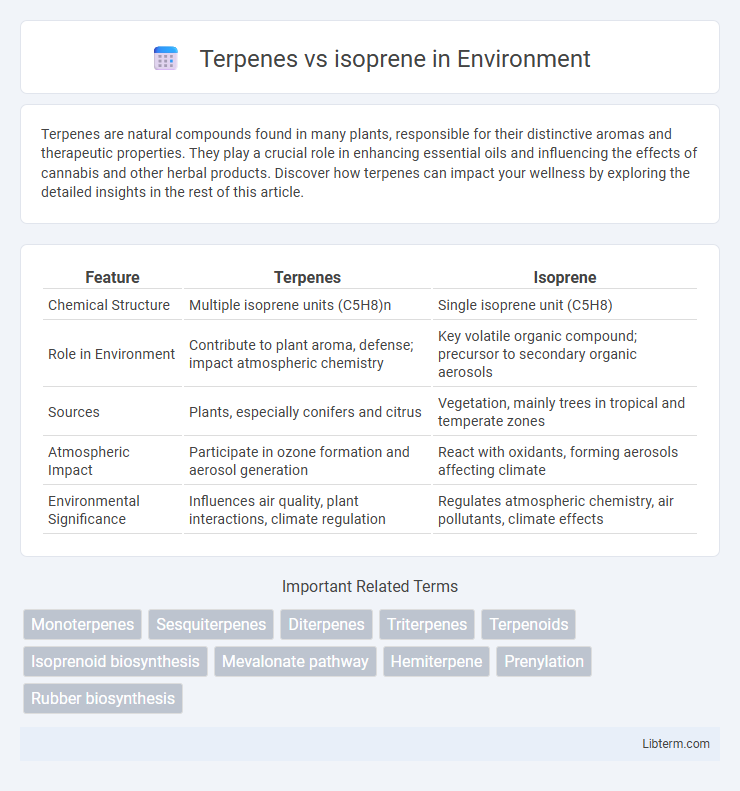Terpenes are natural compounds found in many plants, responsible for their distinctive aromas and therapeutic properties. They play a crucial role in enhancing essential oils and influencing the effects of cannabis and other herbal products. Discover how terpenes can impact your wellness by exploring the detailed insights in the rest of this article.
Table of Comparison
| Feature | Terpenes | Isoprene |
|---|---|---|
| Chemical Structure | Multiple isoprene units (C5H8)n | Single isoprene unit (C5H8) |
| Role in Environment | Contribute to plant aroma, defense; impact atmospheric chemistry | Key volatile organic compound; precursor to secondary organic aerosols |
| Sources | Plants, especially conifers and citrus | Vegetation, mainly trees in tropical and temperate zones |
| Atmospheric Impact | Participate in ozone formation and aerosol generation | React with oxidants, forming aerosols affecting climate |
| Environmental Significance | Influences air quality, plant interactions, climate regulation | Regulates atmospheric chemistry, air pollutants, climate effects |
Introduction to Terpenes and Isoprene
Terpenes are a large and diverse class of organic compounds produced by plants, consisting of repeating isoprene units (C5H8) arranged in various structures such as monoterpenes, sesquiterpenes, and diterpenes. Isoprene is a fundamental building block, a volatile hydrocarbon with the molecular formula C5H8, serving as the basic unit from which terpenes are synthesized through polymerization. Understanding the structural differences and biosynthetic pathways highlights how isoprene units combine to form the wide variety of terpene molecules essential in ecological functions and commercial applications.
Chemical Structure: Terpenes vs Isoprene
Terpenes are large hydrocarbons composed of multiple isoprene units, each containing five carbon atoms arranged in a C5H8 formula, linked together in various configurations such as linear, cyclic, or bicyclic structures. Isoprene serves as the fundamental building block for terpenes, with its structure consisting of a branched diene featuring two double bonds within a five-carbon skeleton. The chemical distinction lies in terpenes being polymers of isoprene units, while isoprene itself is a monomeric compound with a simpler molecular arrangement.
Biosynthesis Pathways
Terpenes are a diverse class of organic compounds biosynthesized through the mevalonate (MVA) and methylerythritol phosphate (MEP) pathways, which generate isopentenyl pyrophosphate (IPP) and dimethylallyl pyrophosphate (DMAPP), the fundamental five-carbon building blocks. Isoprene, a simple five-carbon hydrocarbon, is directly produced via the MEP pathway in many plants and microorganisms, serving as the foundational unit for larger terpenes and terpenoids. Enzymatic condensation of IPP and DMAPP units forms the various terpene classes, while isoprene synthase specifically catalyzes isoprene formation from DMAPP, highlighting the distinct yet interconnected biosynthetic routes.
Natural Sources and Occurrence
Terpenes are naturally occurring hydrocarbons primarily found in essential oils of plants like pine, eucalyptus, and citrus, contributing to their aromatic properties. Isoprene, a fundamental building block of terpenes, is emitted in large quantities by plants such as oaks and poplars, playing a key role in atmospheric chemistry. Both terpenes and isoprene occur widely in nature, but terpenes form complex structures, while isoprene is a simple five-carbon molecule serving as the enzymatic precursor in biosynthesis.
Physical and Chemical Properties
Terpenes are larger, more complex hydrocarbons built from multiple isoprene units, typically containing 10 to 40 carbon atoms, whereas isoprene is a smaller, five-carbon molecule with the formula C5H8. Terpenes exhibit a wide range of physical states and boiling points due to their varied molecular sizes and functional groups, while isoprene is a volatile liquid with a low boiling point around 34 degC. Chemically, terpenes display diverse reactivity stemming from their numerous double bonds and functional groups, compared to isoprene's simpler diene structure that readily undergoes polymerization and addition reactions.
Industrial and Commercial Applications
Terpenes, composed of multiple isoprene units, serve as crucial raw materials in the manufacture of fragrances, flavors, and pharmaceuticals, exhibiting diverse industrial applications due to their complex structures. Isoprene, a fundamental building block in synthetic rubber production, underpins the commercial manufacturing of tires, adhesives, and elastic materials, driving the automotive and construction industries. Both terpenes and isoprene play pivotal roles in bio-based product development, enhancing sustainability efforts within chemical manufacturing sectors.
Role in Plant Biology and Ecology
Terpenes, composed of multiple isoprene units, play crucial roles in plant defense mechanisms by deterring herbivores and attracting pollinators with their volatile aromatic properties. Isoprene, a smaller hydrocarbon emitted in large quantities by many plant species, primarily protects cellular membranes from heat and oxidative stress, enhancing plant resilience to environmental fluctuations. Both compounds contribute significantly to plant ecological interactions and atmospheric chemistry, influencing biodiversity and climate processes.
Health Benefits and Risks
Terpenes, composed of multiple isoprene units, exhibit diverse health benefits such as anti-inflammatory, antioxidant, and antimicrobial properties that support immune function and reduce chronic disease risks. Isoprene, a fundamental hydrocarbon building block of terpenes, has limited direct health effects but can contribute to oxidative stress and respiratory issues when inhaled in high concentrations from environmental pollution. Understanding the distinct roles of terpenes and isoprene aids in harnessing therapeutic benefits while mitigating potential health risks linked to exposure.
Analytical Methods for Identification
Analytical methods for identifying terpenes and isoprene commonly involve Gas Chromatography-Mass Spectrometry (GC-MS), which provides precise separation and structural elucidation based on molecular fragmentation patterns. Spectroscopic techniques such as Fourier Transform Infrared (FTIR) spectroscopy and Nuclear Magnetic Resonance (NMR) further complement GC-MS by enabling detailed functional group analysis and isomer differentiation. Advanced approaches like Two-Dimensional Gas Chromatography (GCxGC) enhance resolution, making it possible to distinguish complex mixtures of terpenes and isoprene with higher accuracy.
Future Trends in Terpene and Isoprene Research
Future trends in terpene and isoprene research emphasize bioengineering to enhance sustainable production through microbial synthesis and plant metabolic pathway optimization. Advances in synthetic biology enable precise manipulation of terpene synthase enzymes, promoting the development of novel bio-based pharmaceuticals, fragrances, and biofuels. Ongoing studies focus on the environmental impact of isoprene emissions and the role of terpenes in climate change mitigation, leveraging genomics and metabolomics for more efficient and eco-friendly applications.
Terpenes Infographic

 libterm.com
libterm.com